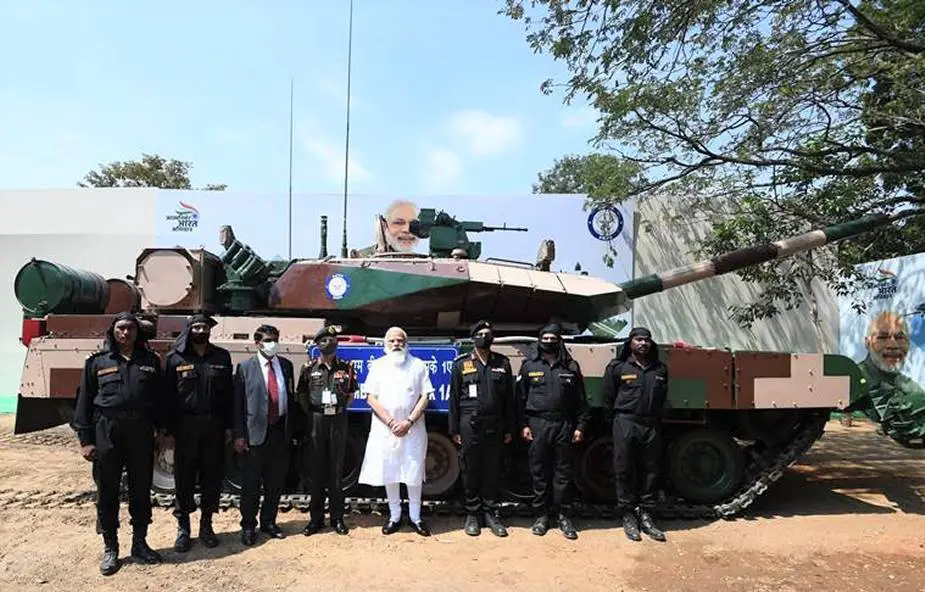Breaking news
Indian Prime Minister Modi hands over indigenous Arjun Mk-1A tank to Army.
Prime Minister Narendra Modi on Sunday, February 14, handed over to the Army the home-made Arjun Mk-1A Main Battle Tankin Chennai, dubbed by him as an example of India's united spirit as the south-made tank will guard the northern borders of the country, The NorthEast Today reports.
Follow Army Recognition on Google News at this link

Indian Prime Minister Narendra Modi in Chennai on February 14. (Picture source: Twitter/@narendramodi)
"The Arjun Mk-1A uses indigenous ammunition. Tamil Nadu is already the leading auto manufacturing hub of India. Now I see Tamil Nadu evolving as a tank manufacturing hub of India," PM Modi said. "A tank made in Tamil Nadu will be used in our northern border to keep our nation safe. This showcases India's united spirit--Bharat's ekta darshan," Modi added. According to reports, the Heavy Vehicles Factory (HVF) at Avadi, has been placed with a Rs 8,500 crore order for manufacturing 118 of these tanks.
The Arjun tank has been designed, developed, and manufactured by the Defence Research and Development Organisation (DRDO)'s Combat Vehicles Research and Development Establishment here. Fifteen academic institutions, eight laboratories and several Small & Medium Enterprises were also involved in the Arjun Mk- 1A. The production order opens up a large avenue in defence manufacturing for over 200 Indian companies and scores of Micro, with employment opportunities to 8,000 people.
Quoting from revolutionary Tamil poet and freedom fighter Mahakavi Subramanya Bharathi, Modi said that inspired by the former's vision, "India has taken a massive effort to become self-reliant in the defence sector."
The Arjun Main Battle Tank project was initiated by DRDO in 1972 with the Combat Vehicles Research and Development Establishment (CVRDE) as its lead laboratory. The objective was to create a “state-of-the-art tank with superior fire power, high mobility, and excellent protection”. During the development, the CVRDE achieved breakthroughs in the engine, transmission, hydropneumatic suspension, hull and turret as well as the gun control system. Mass production began in 1996 at the Indian Ordnance Factory’s production facility in Avadi, Tamil Nadu.
The Indian Army received the first batch of 16 tanks in 2004 and they were inducted as a squadron of the 43rd Armoured Regiment. In 2009, the first Arjun regiment of the Indian Army had 45 tanks. By 2011, over 100 tanks had been delivered. In 2010, the Indian army ordered another 124 Arjuns. The Ministry of Defence ordered another 118 units of the Arjun Mk-1A. These are the units being inducted now at a revised cost of over Rs 8,400 crore.
The Mk-1A version has 14 major upgrades on the earlier version. It is also supposed to have missile firing capability as per the design, but this feature will be added later as final testing of the capability is still on. However, the biggest achievement with the latest version is 54.3 per cent indeginous content against the 41 per cent in the earlier model.

The latest generation of Indian-made Arjun main battle tank. (Picture source: Army Recognition)
Arjun Mk-1A, a third-generation MBT
The Arjun is a third-generation main battle tank developed by India's Defence Research and Development Organisation (DRDO), for the Indian Army. The development of the tank began in 1972 by the Combat Vehicles Research and Development Establishment (CVRDE), a laboratory of DRDO. The first batch of 16 production version Arjun tanks was received in 2004 and they were provided as a squadron to the 43 Armoured Regiment. The regiment was later made up to 45 tanks on 25 May 2009 making it the first Arjun regiment of the Indian Army.
The Arjun has a crew of four and is armed with one 120 mm rifled gun able to fire APFSDS (kinetic energy penetrator) rounds, HE, HEAT, High Explosive Squash Head (HESH) rounds at a rate of 6–8 rounds per minute. the gun of the Arjun is also capable to fire Israeli developed semi-active laser-guided LAHAT missile. The Arjun can carry 39 rounds in special blast-proof canisters. The second armament of the tank includes on 12.7 mm anti-aircraft machine gun mounted on the commander hatch turret and one 7.62 mm coaxial machine gun.
The turret and glacis are protected with "Kanchan" ("gold") modular composite armor, which derived its name from Kanchan Bagh, Hyderabad, where the Defence Metallurgical Research Laboratory (DMRL) is located. Kanchan is made by sandwiching composite panels between Rolled Homogenous Armour (RHA) able to defeat APFDS (Armour-piercing fin-stabilized discarding sabot) and HEAT (High-explosive anti-tank) rounds.
The Arjun Mk-1A is an upgraded version of the Arjun Mark 1 offering more firepower, protection, and mobility. The hull and turret of Arjun Mk.1A have been modified to give a lower silhouette making detection more difficult, while it also supports the newly developed Thermo-Baric (TB) and Penetration-cum-Blast (PCB) ammunition.
The Arjun Mk-1A is fitted with an improved Gunner's Main Sight (GMS) integrated with Automatic Target Tracking (ATT) which are all connected to a computerized fire control system enhancing the first round kill capability that guarantees accurate engagement even under adverse conditions, panoramic sight (CPS Mark II) integrated uncooled thermal imager and night vision camera with binocular sights, laser rangefinder for an advanced hunter-killer capability, To improve mobility due to an additional increase in weight, an Advanced Running Gear System (ARGS) has been developed where the hydropneumatic suspension system is completely redesigned to enhance agility.


























